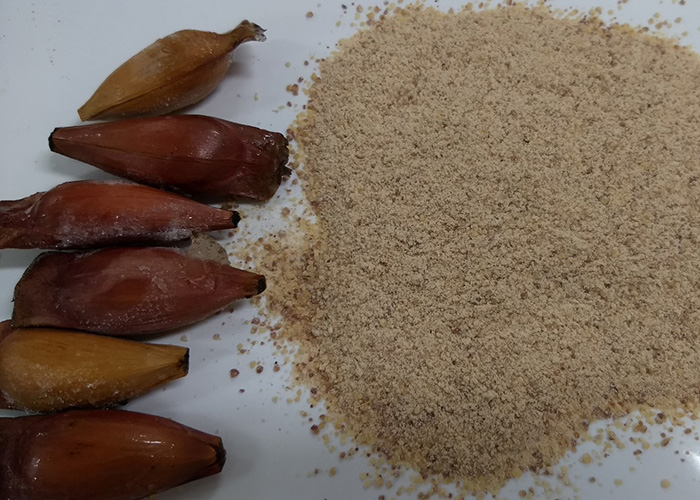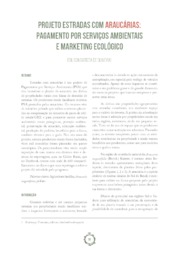Research develops nutritious gluten-free pine nut flour
Research develops nutritious gluten-free pine nut flour
In order to put the nutricional value of araucaria pine nut to good use as a functional gluten-free food, Embrapa Forestry (Colombo, PR) developed two types of flour that can be used in different food preparations such as cakes, doughs and breads. Made with cooked pine nuts and cooked and dry pine nuts, which incorporate antioxidant and mineral compounds from the pine nut shells, the new products offer differentiated nutritional value and are gluten free, which make them an excellent alternative for the diets of people who suffer from coeliac disease.
The Embrapa researcher Cristiane Helm points up that the market for coeliac patients or people with gluten-restricted diets is increasing, and bets on araucaria nut flour's differential in this niche. "It is a product that provides good aeration to doughs, which makes breads, pastry and cakes have a more pleasant flavor, and supplies high nutritional value to consumers, as the araucaria nut is rich in dietary fibers, antioxidant compounds and starch", she informs.
The two flours have different kinds of preparation, processing and culinary indication, but both can be used as an ingredient in recipes or simply mixed into diets.
Increased consumption pushes araucaria nut productionThe nut is the seed of the araucaria (Araucaria angustifolia), a forest species that is native to Brazil, present in all of the country's South and in the high regions of São Paulo, Rio de Janeiro and Minas Gerais. While, on the one hand, the trend is of increased nut consumption due to its many nutritional properties, on the other hand, this generates a demand for the raw material, with subsequent need to encourage the planting of araucarias. For this purpose, Embrapa Forestry has been developing a protocol for early araucaria nut production. The goal is to reduce the time the seeds take to produce from the current 12 - 15 years to 6 - 10 years. The Corporation has also worked on the Roads with Araucarias project and on pre-breeding action for the species, among other efforts. Learn more clicking here. |
Cake with more fiber
Master's degree research developed by Monica Ikeda, a postgraduate student in Food Engineering from the Federal University of Paraná (UFPR), co-advised by the researcher Rossana Catie Bueno de Godoy, from Embrapa Forestry, analyzed mixes between rice flour, which is traditionally used for gluten-free products, and araucaria nut flour for the preparation of a cake pre-mix.
The intention was to establish a product with structural, sensorial and nutritional properties aimed at gluten-restricted diets. In addition to the acceptance of flavor, the research concluded that the araucaria nut flour attributes better texture and lower perishability to the final products, and also reduces floury and sunken aspects, a frequent complaint from consumers. Cakes prepared with higher araucaria nut flour content also present twice as much dietary fiber content.
Beyond coeliac patients
In addition to being gluten-free, araucaria nut has high content of proteins of high biological value, as it contains all essential aminoacids - those that are not synthecized by the human body -, food fibers and starch. Hence its potential as functional food has drawn the interest of researchers and consumers.
Araucaria nut is a product with low lipidic content and its flavor does not change salty or sweet products, which can stimulate the production of both salty and sweet cereal bars. Sensorial analyses with extruded products (chips), developed by Embrapa Food Technology (Rio de Janeiro, RJ), are already being conducted, with the possibility of composing healthier, less caloric foods.
"Our research indicates that araucaria nut has a 3% concentration of resistant starch, which can help to reduce glycemia", Cristiane Helm asserts. "As it is rich in fiber, consumption can help prevent intestinal diseases, on top of its low glycemic index and antioxidants", she adds.
The nutritional characterization of the seed also shows the presence of linoleic (Omega 6) and oleic (Omega 9) fatty acids, which contribute to reducing cholesterol, and thus help to prevent cardiovascular diseases. "With regard to resistant starch", Helm explains, "the 3% concentration in araucaria nut indicates it can help to reduce glycemia". (Click here to learn about araucaria nut's nutritional value.)
Seeking partners for production
The researcher Cristiane Helm reports that previous tests have already proven the flour's excellent results. The product is now apt for large-scale production. "We believe that it can be interesting for agroindustries to produce and trade the two types of flour. That is why we are looking for partnerships, so that they will be soon available to the consumer market", she announces.
Translation: Mariana Medeiros
Katia Pichelli (MTb 3594/PR)
Embrapa Forestry
Press inquiries
florestas.imprensa@embrapa.br
Phone number: +55 41 3675-5638
Further information on the topic
Citizen Attention Service (SAC)
www.embrapa.br/contact-us/sac/


